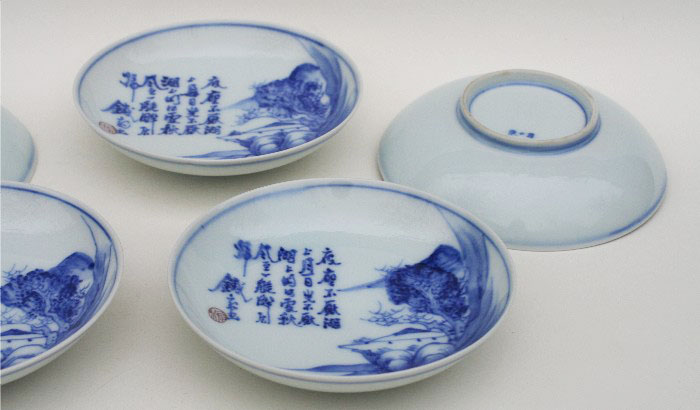Nanga/sometsuke
Set of 5 saucers - dozara: Autumn breeze - Aki kazeSigned: Tessai sho & Hakuzan sei
Seals: Tomioka
Technique: Kyôyaki sometsuke (Seikaji) - Translucent blue and white porcelain with a hand painted cobalt blue underglaze decoration. Ø 14
Condition: one dish with a crackled hair line in the glaze, otherwise fine
The poem reads:
夜座不厭湖上月
日光不厭湖上山
何處秋風至
一艇畔居歸。
At night I can’t quit sitting and [watch] the moon at the lake,
in the sun light I can’t quit looking at the [reflection] of the mountains on the lake.
From where comes this sudden autumn breeze blown in?
A small boat returns to the house at the shore. (HK,MR)
The first stanza is a variant on lines from a poem by Zhang Wei
(Tang dynasty), included in the Complete Tang Poems.
The third line is the first line of a poem by Qiu feng yin by Liu Yuxi (772-842).
Tessai was born in Kyoto into a family selling robes and accessories for the Buddhist clergy. As a result of a childhood illness he became partly deaf. It was therefore considered improbable that he would ever become a successful shopkeeper. Instead he went to study the Japanese classics in order to become a Shinto priest. He also did Chinese studies, specializing in the teachings of the neo-confucianist Wang Yang-Ming. Later he would study Buddhism, literature and Shingaku, a semi-religious system for self-cultivation.
As a youth Tessai met Ōtagaki Rengetsu (1791-1875) and became her special protégé. She taught him waka and encouraged his artistic inclinations. Tessai was mainly self-taught, indepently studying Nanga painting and learning from friends. He was, however, strongly influenced by Shinten’ô.
In the final years of the Tokugawa era Tessai was involved in the pro-imperialist movement. For fear of being arrested he left Kyoto in 1861 and travelled to Nagasaki. It was the first of many trips; Tessai became and avid traveller. In 1882 he settled in Kyoto where he spent the rest of his life. Although he worked as a priest at several Shinto shrines, he saw painting as his chief occupation. Between 1894 and 1904 he was a teacher at the Kyoto Prefectural Art School and he was a regular contributor to exhibitions of the Nanga Society. In 1917 he was appointed Artist to the Imperial Household and towards the end of his life he received an honorary court-rank. Tessai is often seen as the last great exponent of the Nanga school.
Reference:
Kanazawa
Aichi arts Center 1996
Kato 1998
Morioka & Berry ‘99 pp. 116-121 (# 20-21)
Morioka & Berry ‘08 p. 305-06 (# 11, 46)
Roberts p. 181
Araki pp. 2754-2755
Aburai pp. 266-267
Price: SOLD

